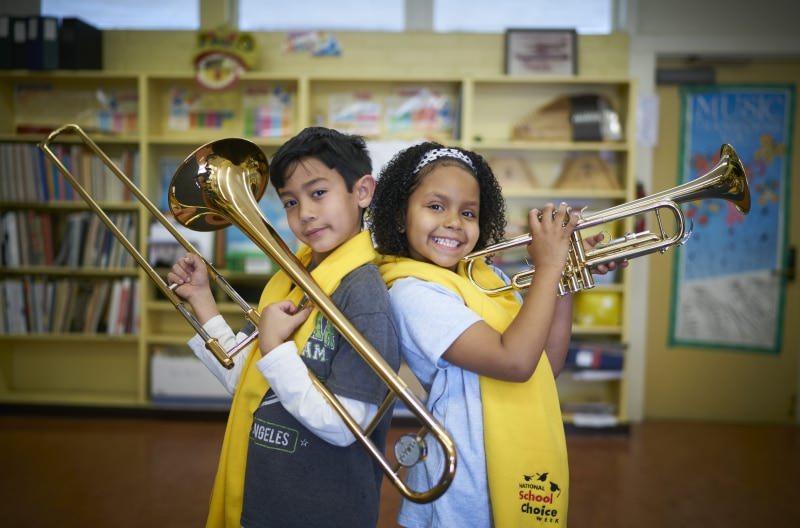Escape the Internet with These Offline Learning Ideas
Whatever educational environment you chose for your child— traditional public school, public magnet school, public charter school, private school, online school, homeschooling, or microschool— it’s important to find a balance between time online and offline. Could you use some fun, offline learning activities?
There are plenty of great online learning resources you can use at home. But, it’s equally important to remember to give students’ eyes and bodies a break from screens. If your child’s attention span (or your internet connection) is wavering, give offline learning activities a try.
Don’t forget that students need mental and physical breaks from online learning. Allow time each week for fun, offline learning activities.
When asked to describe his #1 tip for engaging in learning activities at home, Andrew Campanella, president of National School Choice Week, said this:
“You DO NOT need to mimic or replicate a traditional school setting in your home. So, if you only do one thing: Encourage your child to discover something productive that sparks his or her curiosity. Then, research it, learn more about it as a family, write about it, and discover the math and science surrounding it. Experts say curiosity is not only a bridge to learning, but to happiness.”
Here are some screen-free ideas for fueling your child’s curiosity. Your family may already be using some of these offline learning ideas, but we bet you’ll find a couple ones you haven’t tried on the list:
Play Board Games.
Sagrada is among the most popular games of 2023, but whatever game you have tucked away on the closet shelf can be a source of fun. Catan, Life, Apples to Apples, Clue, Yahtzee… Board games can support critical thinking and decision-making skills, as well as interpersonal communication skills. Include grandparents or friends in the fun via speakerphone.

Bake.
Dust off the recipe box. Baking is an offline activity that can be simple enough to help a preschooler with or challenging enough to excite a high school senior. Soft pretzels require just a few ingredients and allow children to practice rolling and twisting dough, boiling water, and baking. If you have a high schooler looking for a hefty challenge, encourage them to make make homemade pasta or choose a technical challenge from the Great British Baking Show for themselves. Math, motor skills, and taste buds will all soon be engaged.
Take Something Apart.
Did you know that a 1985 cassette tape has 24 parts?
One of the best at-home engineering experiments isn’t necessarily to build something… it’s to take something apart. Encourage your child to take apart a flashlight, old phone, old drill, old watch, or old stereo. Let the disassembly be a learning adventure, and don’t worry too much about putting it back together again.

Read.
Reading is not only vital for vocabulary and analytical skills, but also for memory and concentration. In The Enchanted Hour: The Miraculous Power of Reading, Meghan Cox Gurdon writes, “Reading aloud is a restorative that can replenish what technology leaches away… It brings joy, engagement, and profound connection for children, teens, adults—everybody. Reading out loud is probably the least expensive and most effective intervention we can make for the good of our families.”
Encourage your student to read aloud, to you, to himself, or to a sibling. Consider setting up a Skype date so your child can read aloud to a relative or friend. Hand your child this list of 50 different ways to read and see how many they can check off in a week!
Bury Treasure.
An indoor scavenger hunt is a fun offline activity that explores problem-solving. Ask a family member to hide an item they consider valuable. Then, while the family member who hid the item gives clues, the rest of the family can search for the treasure. Once the hidden item has been found, ask the member who hid it to talk about why that item is important to them. Take turns until every family member has “buried treasure.”
Discover Classic Movies (or Classic TV).
While this activity involves a screen, it doesn’t necessarily involve internet, so we’ll still count it as an offline learning idea. Pop in an old DVD of a classic movie or television show, then discuss the differences between cinema and television from the past and what we see today. Let the discussion become an impromptu history or social studies lesson… What year was the movie or show you watched made and what has changed since then?
Sew.
Help your student tackle a simple sewing project. Ask them what they’d like to make and brainstorm how to make it happen together. Or, choose a project from this list of quick sewing ideas.
If sewing machines and needles sound daunting, consider letting your student use fabric scraps to DIY a notebook cover. Sewing can develop students’ creativity, logistical skills, and self-confidence, not to mention that it might come in handy in the future.

Build an Obstacle Course.
Encourage your child to create an outdoor obstacle course for the whole family to try out. If you have work out equipment, sports equipment, or squirt guns, incorporate use of them into the obstacle course. Besides combining fun and fitness into an offline activity, obstacle courses can be customized for students of any age.
Practice a Card Game.
Print out directions for Gin Rummy or Peanuts (which is also called Nerts). While they make take a round or two to learn, both can be addictively fun once you know how to play! Spoons is another great game, one that can be taught to children as young as five or six. Challenge older students to learn Blackjack or develop strategies for Hold ‘Em.
Draw Dream Houses.
Bring paper and markers to the table and invite your child to imagine and draw their dream house. Encourage them to add creative elements (like a slide from the playroom to the kitchen) and talk about what they would include and why. Use this offline activity to explore scale, spatial reasoning, and design thinking.
Create a Poem with a Marker.
Turn an old newspaper or mailer into word art with a marker or whiteout. If you’re using a marker, first draw a rectangle around words you like. Then, color everything else so that only your chosen words remain. That’s your poem. If you’re using whiteout, simply whiteout all the words you don’t wish to keep, until you’re left with a poem. After the poems are dry, use them to decorate the walls. Playing with words can be a wonderful way for students to engage their imagination and express their personality.

Juggle.
Encourage your child to begin learning how to juggle, either with their hands or their feet! Learning to juggle is obviously an exercise in patience, but it can also be a great way to develop dexterity and concentration.
Write a Short Story as a Family.
Work together as a family to plan out and write a short fictional story. Besides requiring collaboration, the activity will allow students to practice brainstorming, choosing their favorite ideas, and editing. Finish the story by picking a title for it and reading it out loud.
Plant A Garden.
It’s a good time of year to plant some seedlings, even if only for a container garden. Find recommendations for planning your garden. Gardening projects can nurture an interest in botany and encourage environmental stewardship. Plus, if you go outside to plant, the fresh air involved makes it the ultimate offline learning activity!

Give Dinner a Theme.
Choose a meal to make into an extra special social occasion. Have a themed dinner that family members dress up for: a fancy dinner, a silly dress-up dinner, a color-themed dinner, etc.
Or, if the weather permits it, make a picnic-themed meal and eat it in the backyard on a blanket. Invite a friend to join the special occasion.
Set Up Camp in the Backyard.
Borrow a tent from a friend and spend a night camping in your own backyard. Backyard camping can be an opportunity for children to enjoy the outdoors while developing basic camping skills. If you want to get fancy, you can also lead some camp activities or cook campfire food.
Mail Letters.
Help your child write a thank you letter to their teacher! Or, your child can write and mail a letter to a relative or friend, asking them to write back. If you’re interested in receiving international mail, help your child send a postcard through Postcrossing. After you register for a free account, Postcrossing will assign you a member’s address to send a postcard to. Once they receive your postcard, you’ll receive a postcard from another Postcrossing member in an international location. While it may take some patience, it can be very exciting to receive a postcard from Thailand, Lithuania, Japan, or elsewhere. It’s an exercise in writing plus geography!

Take a Color Walk.
A few years ago, an interactive art exhibit debuted in San Francisco celebrating the wonder of color and creativity. The temporary exhibit was so successful it was transformed into The Color Factory museums in New York, Texas, and Illinois.
But you don’t need a museum ticket to be surprised by the colors around you. Students of any age can go on a walk, indoor or outside, in search of colors. How many can be found on one walk around the neighborhood, or in a nearby park?
Take a Coin Walk.
Select a coin with your child and decide which side (heads or tails) represents right and which side represents left. As you go on a stroll outside, pause whenever you are at an intersection (or after a certain number of steps). Flip the coin and turn left or right according to which way it lands. Be on the lookout for whatever adventure awaits!
Look at Old Photos.
Discovering history at home may be easier than you think. For instance, you can go through old photographs with your family and talk about your heritage.
This can also be a great offline activity to include grandparents in over the phone or when they visit. Kids can ask them questions about their childhood and where they grew up.
Paint a Mandala Rock.
Use acrylic paint and Q-tips to paint geometric designs on smooth rocks found in nature. Start by painting a black circle on the rock and letting it dry. Then, use a round tool (such as a Q-tip, pencil eraser, or blunt colored pencil) to create symmetric patterns on top of the black. During this activity, it can be fun to notice and talk about which colors and patterns each family member chose to use.

Do a Jigsaw Puzzle.
Puzzles are timeless. They’re also valuable for improving memory and hand-eye coordination. Consider designating a side table in your home to a jigsaw puzzle. Encourage your child to go over and put a few pieces in whenever they need a break from other activities. If that sounds too simple, you can check out these ideas for making puzzles more challenging.
Pick Up a Musical Instrument.
Do you have a piano, a keyboard, a guitar, or another musical instrument in the house? Encourage your child to sit down and see what they can learn. Learning a musical instrument not only helps children develop motor skills, but can also be relaxing and build their imaginations.

More Offline Learning: Printables and Lists
For more offline learning ideas, visit our Activity Center or print out this ABCs of Screen-Free Time at Home, these 77 Simple STEM Activities for Families, or Wade Whitehead’s Ideas for Fun, Meaningful, and Generally Pixel-Free At-Home Learning. Also check out the Boston Children’s Museum’s list of 100 Ways to Play and KID Museum’s Make It!: Outside Edition.
What’s your favorite at-home, offline learning activity? Send us a line letting us know at info@nscwmainstage.wpengine.com.
